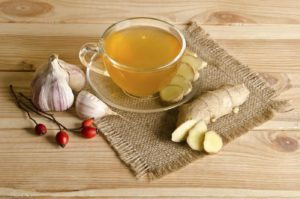What I detail in this blog post will, hopefully, give you what I actually enjoyed last winter—not one single cold! Rather than list a ton of cold remedies, which no doubt most of you already have, I’d like to discuss why we experience what can turn out to be weeks of recurrent misery with one cold symptom after another, all winter long. Permit me then to recommend some worthy ideas that you won’t generally find online or in countless other blog posts.
Colds are robbers of the good health that most of us enjoy during the summer months, and we all want to avoid them. That said, I want to dig a little deeper into why colds are mostly a winter phenomenon and also offer a few nourishing winter tips. I hope you may actually enjoy these, or that at least they’ll help you minimize sickness during the long months of cold winter weather (if, in fact, you happen to live where winter’s wrath can easily bring you down). Yes, you can actually have a pleasant, sick-free winter.
Most Frequently Asked Questions
- Why do I get more colds in the winter?
- What can I do to strengthen my immune system?
- What if I choose to use antibiotics?
- What are the best ways to avoid getting colds?
Obviously, these and many other related questions have been asked of the best scientists and researchers who study colds. For the most part, nobody agrees on one single answer. However, as I’ve mentioned in several of my blog posts, body temperature seems to play a role in the relationship between virus incubation and inflammation.
Let’s take a look at a few of these studies to see if we can’t agree that allowing our internal body temperature to drop below 98.6°F may be one reason we succumb to various winter illnesses as well as other types of disorders. For even more background, read “Sweat It Out,” my comprehensive blog post on the subject of body temperature.
Why Do I Get More Colds in the Winter?
Key point from WebMD (emphasis mine):
Though it’s never been scientifically confirmed, conventional wisdom has it that winter is the season of sniffles. Now, new animal research seems to back up that idea. It suggests that as internal body temperatures fall after exposure to cold air, so too does the immune system’s ability to beat back the rhinovirus that causes the common cold.” The article goes on to state that “cooler ambient temperature would likely increase the ability of the virus to replicate well and to develop a cold.
Key point from Business Insider:
Our genes change with the seasons, just like the weather…A recent study found that as much as a quarter of our DNA actually changes with the seasons: During the winter months, the study found, our bodies pump up the levels of many of the genes linked with inflammation, triggering the tell-tale signs of swelling and discomfort that our bodies use to protect us from colds and the flu.
Personal note: There are, of course, many other articles, but from these two reliable sources alone we can see that there are various answers to the question of why we get colds. Read on for testimony from one of my clients who convinced me that it is indeed possible to circumvent and/or minimize the misery colds cause us and our children every winter. But first, let’s have a serious discussion about the immune system.
What Can I Do to Strengthen My Immune System?
Immune system health is a complex issue, so I personally don’t believe it’s possible to attain a 100 percent perfectly functioning immune system all the time. Maybe in the heavens (smile). Nevertheless, some important basics can make us less susceptible to infection, inflammation, and other disorders that are dependent on a less-than-robust immune system. Allow me to share some of what I’ve learned from my own studies and also from the experts over the years.
Immune System Basics
Due to the fact that the immune system is a group of interwoven cells, organs, and glands that comprise various parts of the body rather than any one single organ, we’re often tempted to take synthetic supplements in the form of so-called “healthy” powders, protein drinks, etc., etc. They all promise to strengthen our immune system—or even totally restore it. We then wonder why, after dutifully taking our expensive treatments, we continue to experience colds, sinus infections, and other related symptoms. Puzzling, isn’t it?
Addressing the health of the following key body parts is, in my opinion, the only way to maintain a strong, functioning immune system, and the experts I’ve consulted with agree with me. These key portions of the body are as follows:
The digestive system: This is the first line of defense in protecting our overall well-being. And the stomach, where hydrochloric acid (HCI) is produced, is of particular importance. HCI breaks down the food we ingest and kills pathogens and toxins in our food. HCI is also a deterrent to parasites. It’s important to note that HCI begins to wane after the age of forty. Medications, such as acid blockers for acid reflux, interfere with HCI production and other digestive functions.
The intestine-immune connection: You’ve probably heard that a full 70–90 percent of the immune system is dependent on the health of our digestive system. There are numerous references to this fact in medical and holistic literature. It’s often called our “second brain” or the “center of digestive intelligence.” This immune-intestine connection starts with the fact that our bodies are 90 percent bacteria.
Yes, for every cell in your body, you have nine cells of bacteria living in and on your body. And most of that bacteria (called intestinal flora) lives inside your intestinal tract. That’s why the health of your intestinal  flora is paramount to the health of your body.
flora is paramount to the health of your body.
Signs that your immune system is out of balance are: food and seasonal allergies, chronic inflammation, chronic sinusitis, and colds and flus that linger for weeks.
The “four pillars” of the immune system: These are the other organs critical to the healthiest immune system possible:
- Thymus gland
- Spleen
- Liver
- Bone marrow
Understanding these major systems requires some specific knowledge. Learning about them is paramount if you would truly like to strengthen your body so it can fend off or shorten what I call the dreaded winter miseries. I invite you to read an easy-to-understand but comprehensive overview in my recent blog post, “Healing the Immune System.”
What If I Choose to Use Antibiotics?
The following information is excerpted from Gut and Psychology Syndrome by Dr. Natasha Campbell-McBride (emphasis mine):
- Antibiotics have a devastating effect on beneficial bacteria in the human body, not only in the gut but in other organs and tissues.
- Antibiotics change benign bacteria, viruses, and fungi to pathogenic organisms, giving them an ability to invade tissues and cause disease.
- Antibiotics make bacteria resistant to antibiotics, so the industry has to work on more and more powerful new antibiotics to attack these new changed bacteria. [Note: A good example is tuberculosis, where wide use of antibiotics has created new varieties of Mycobacterium tuberculosis, which is resistant to all existing antibiotics.]
- Antibiotics have a direct damaging effect on the immune system, making us more vulnerable to infections, which leads to a vicious cycle of more antibiotics and more infections.
Despite the unfortunate consequences noted above, antibiotics still seem to be the first line of defense for many people.
Personal note: Above all, you should absolutely be sure that there is a very serious need before you use antibiotics yourself or subject your children to them. For a great book on the topic of natural antibiotics, read Herbal Antibiotics by Stephen Harrod Buhner.
Nourishing Winter Tips
Fermented foods: Since the digestive system is truly the first line of defense, as noted above, we would be wise to consider the amazing benefits of fermented foods. When we keep our digestive system in good working order, we simultaneously nourish the four pillars of the immune system (noted above).
If you’re not familiar with how to make these wonderful foods, I suggest purchasing my Cook Your Way to Wellness DVD. You can also view it by chapter on Vimeo.
As described in Making Sauerkraut and Pickled Vegetables at Home by Klaus Kaufmann and Annelies Schoneck, the benefits of lactic acid in fermented foods are numerous. Here are just a few:
• Prevents decay, not only in food but in the bowels.
• Stimulates the peristaltic movement of the intestines.
• Assists in the circulation of the blood.
• Has a harmonizing effect on the stomach, strengthens the acidity of the gastric juice when production lags, and reduces acidity when production is up.
• Relieves the burden on the digestive system by significantly improving intestinal digestion.
• Increases nutrient absorption.
Bone broth: This next recommendation is certainly a must. Bone broth, and especially medicinal bone broths, are vital during the winter months. Please see my recipes for medicinal bone broths in my blog post “Medicinal Bone Broth for Winter’s Woes.”
In Sally Fallon’s Nourishing Broth, you’ll find an abundance of information on the vital substances in bone broth, and how they come about. Below are four marvels of bone broth and how they keep our immune system in good working order.
The Four Marvels of Bone Broth
- Collagen: Holding the Body Together
- Gelatin: Consisting of 84–90 Percent Protein
- Bone: Sustaining the Living Framework
- Bone Marrow: The Body’s Blood Bank
To learn more about the full benefits and descriptions of the Four Marvels of Bone Broth, read my blog post “Fish Broth and Your Thyroid.”
An Important Testimony for Nonbelievers (Smile)
Approximately three years ago, a client approached me about nutritional i ssues. Toward the end of our conversation, she asked how she might mitigate symptoms her two children suffered from when dealing with recurrent and sometimes very bad colds, sinus issues, and other winter illnesses, from November till after the warm weather returned. She thought many of her children’s illnesses were caused by other sick children in school.
ssues. Toward the end of our conversation, she asked how she might mitigate symptoms her two children suffered from when dealing with recurrent and sometimes very bad colds, sinus issues, and other winter illnesses, from November till after the warm weather returned. She thought many of her children’s illnesses were caused by other sick children in school.
I knew this family ate relatively well, although they weren’t entirely dedicated to making bone broth or fermented foods. I also knew that the children’s internal body temperature must be kept at 98.6°F during the winter months, so I suggested the following:
- Give her children as much coconut oil—a definite internal body warmer—as possible on a daily basis.
- Prepare the children bone broth using recipes from Nourishing Broth and my blog post about medicinal broth.
- Start them on a daily dose of fermented cod liver oil from Green Pastures, another super internal body temperature warmer.
In the whole food supplement area, I suggested:
- Add chewable Congaplex, a Standard Process whole food supplement that, among other concentrated whole foods, also contains thymus gland, a specialized primary lymphoid organ of the immune system.
- Add chewable Lactic Acid Yeast Wafers, after or with the children’s meals (unless she intended to make fermented foods as shown in Cook Your Way to Wellness or in Sally Fallon Morrell’s Nourishing Traditions).
She ordered a full case of the chewable Congaplex and another of Lactic Acid Yeast Wafers, along with sixteen bottles of the fermented cod liver oil. My largest order of these products at one time in any one year! I was hoping to hear from her in the event that my recommendations didn’t work, so we could improve on the protocol.
My surprise came when I finally heard from her in the late summer of the following year. She emailed me saying she wanted to order another winter’s supply of chewable Congaplex, Lactic Acid Yeast Wafers, and Green Pasture Fermented Cod Liver Oil!! She informed me that she’d learned to make bone broth meals but hadn’t yet had time to start fermenting.
She confided that the children finally got through their first winter in years with nothing but a few sniffles, which their mother took care of by increasing the chewable Congaplex and coconut oil. She also had them eating lots of chicken bone broth soups made with onions, garlic, and other medicinal roots and vegetables for the entire day while keeping them warm. She has since purchased The Nourishing Traditions Cookbook for Children and now has the kids totally involved in their own health needs. Below is one of their favorite recipes for sore throats Need I say more?
Recommended Whole Food Supplements
This woman depended on my knowledge and expertise to help her with the right choices. A local chiropractor, naturopathic physician, or holistic practitioner who uses Standard Process products is your best bet. They will help you choose the appropriate supplements for you and test for the right dosage.
Standard Process is the only whole food supplement I recommend. Why? Because when you properly and faithfully take them as recommended by your local Standard Process practitioner, they simply work wonders. Find a practitioner near you.
Personal note: I don’t recommend purchasing Standard Process supplements online from sites such as Amazon, etc., as you have no guarantee they’ve been kept at optimum temperatures or have valid expiration dates. Additionally, dosages are most effective when you’re tested by your local health practitioner.
The People’s Pharmacy
As I mentioned above, you can find some super blogs that provide full-bodied sources for every type of cold remedy you could wish for. However, I heard Mark Anderson recommend one such source at one of his great seminars. It’s called The People’s Pharmacy Guide to Home and Herbal Remedies. Since this book was written many years ago, it’s inexpensive, and it’s an absolute must-have. Below are a few of the cold remedies that I especially liked and would recommend.
A Few Body Warming Recipes from The People’s Pharmacy
Ingredients
1 quart spring water
Fresh ginger, the size of a thumb
½ cup fenugreek seeds
2–3 shakes crushed red pepper (optional—I wouldn’t advise for children)
Instructions
- Slice the ginger very thinly, or crush it.
- Combine all ingredients in a saucepan and bring to a boil.
- Reduce heat and simmer 10 to 15 minutes. Sip it warm. Then lie down on your back. The mucus will loosen and the cough will become productive.
Garlic Toast
For this recipe, I recommend lots of butter and the use of whole grain toast. The butter aids in digestion and the whole grain bread is packed with nutrients.
Ingredients
1 raw clove garlic, mashed
1 slice toast or English muffin
Instructions
- At the first sign of a cold, mash the clove of raw garlic and spread it on a piece of toast or English muffin.
- Do this 2–3 times during the day. Symptoms will be reduced within hours.
Ginger-Garlic Tea with Cinnamon
See my suggestions in italics.
Ingredients
5 slices fresh lemon
5 slices fresh ginger root
2 cinnamon sticks (or ½ teaspoon cinnamon)
10 whole cloves fresh garlic (minced)
1 quart water
Instructions
- Simmer ingredients for 15 minutes. Strain off solids.
- Drink 1 cup every 3–4 hours at the first sign of a cold.
The recipe below isn’t from The People’s Pharmacy, but you’ll love these cookies, and they’re a great way for you or your children to get more coconut in your system!
Sugar-Free No-Bake Coconut Cookies
—Adapted from Nicole Eckman, RD
Ingredients
1½–2 cups unsweetened coconut flakes
2 tablespoon raw cocoa powder (optional)
½ cup coconut oil, slightly melted
¼ teaspoon vanilla extract
Alternatives: Feel free to add 1 tablespoon almond butter. You may also substitute 1 teaspoon carob powder for cocoa powder, and/or replace half of the coconut oil with butter. Personal Note: Although this recipe includes the cocoa powder as an alternative flavoring ingredient, I would like to mention that Sally Fallon of the Weston A. Price Foundation warns against cocoa in any form due to the theobromine inherent in cocoa. Theobromine has a strong stimulating effect on the adrenals. If you are follower of Sally’s Wise Traditions diet philosophy, do not use cocoa or chocolate.
Instructions
- Pulse all ingredients in blender or food processor, stopping to scrape down the sides and bottom, until creamy. If mixture is too dry, increase coconut oil to ½ cup plus 2 tablespoons. (Dryness might be caused by larger coconut flakes, so adjust that amount as well if needed.)
- Line a cookie sheet with parchment paper.
- Scoop a tablespoon of dough onto cookie sheet. Flatten into round “cookies.” Store in fridge or freezer. Eat as a snack as soon as you are aware of a hypoglycemic event or in time to prevent one.
Note: Should you feel queasy after eating these cookies or other high-fat foods, it may be an indication of gallbladder issues and trouble digesting fats. Standard Process Betafood and/or Cholacol would then be indicated.
Coconut Pops
—From The Nourishing Traditions Cookbook for Children, p. 207: “These popsicles are especially good to eat when you have a cold or sore throat. Coconuts contain a special fat that helps your body fight bad bacteria.”
Ingredients
1 can organic whole coconut milk
¾ cup coconut water
¼ cup maple syrup
Tools
4-cup glass measuring cup
Spoon
Popsicle molds
Instructions
- Put the ingredients in a glass measuring cup or bowl with a pour spout.
- Mix together with a spoon.
- Pour into popsicle molds and freeze for least 4 hours.
Water Kefir Pops: Pour Grape Cooler (page 138) or Coconut Cocktail (page 140) into popsicle molds and freeze.
AUTHOR’S NOTE
To choose your organically grown and fresh ingredients wisely, use the following criteria:
- chemical- and hormone-free meat
- wild-caught fish
- pasture-raised, organic eggs
- whole, unrefined grains
- virgin, unrefined, first-press organic oils
- whole-food, unrefined sweeteners
- pure, clean, spring water
- sea salt
- raw and/or cultured milk and cream products
Photos from iStock/shironosov (at the top); sanjagrujic (man sneezing); Artfoliophoto (mother kissing child); white_caty (ginger tea)





I love this article. The warming tea and broth reminders are so helpful with the changing of the seasons. My grandson’s teeth were healed and are cavity free thanks to the WAPF diet and we are all healthier. Thanks, Maria.